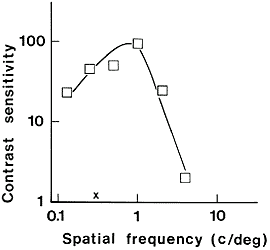
This contrast sensitivity curve depicts visual function of a boy at the age of six years with damage to both occipital lobes leading the central scotoma and loss of form perception, discrimination and recognition of details. Detection of long lines, computer generated gratings, was normal at the lower spatial frequencies but decresed at the higher spatial frequencies. The highest frequency detected was 6 cpd, the same frequency that has been recorded in the superior colliculus of monkeys after removal of occipital cortex1. Now this boy is adult and can describe that "there are forms on this chart" but does not perceive the difference between letters and numbers at the size of 40M at a distance of 40cm. It is difficult to imagine how the world looks like without perception of details that we experience necessary for seeing. It is important to know that this person is not functionally blind. On the contrary, he has useful vision for orientation, moving and daily activities and recognises people based on their movement patterns.
1. Humphrey NK. Vision in a monkey without striate cortex; a case study. Perception 1974; 3(3):241-255
Paediatric Vision Tests I Vision in Occupational Health I Vision Tests I Main Page